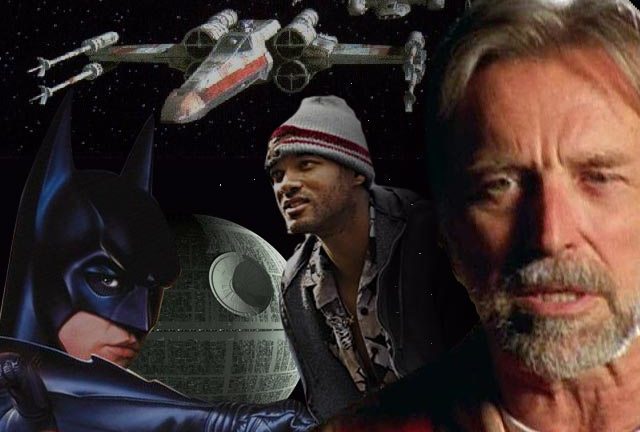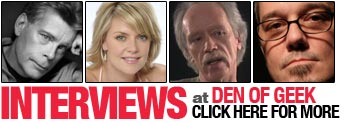The Den Of Geek interview: John Dykstra
From pioneering effects work on Star Wars through to Batman, Spiderman and Hancock, John Dykstra is an SFX legend...

INDEX: On the Dykstraflex | on ILM | on CGI | on Hancock | on Spiderman | on Stuart Little | on Batman And Robin | on videogame development | on future projects | on favourite SFX films | favourite own SFX shots
John Dykstra started his Oscar-winning career in the special effects industry helping out 2001 effect wizard Douglas Trumbull on the extensive optical and model-work on Silent Running (1972). In the mid-seventies Dykstra was chosen by George Lucas to head up Industrial Light And Magic, a new SFX facility that would provide the seemingly impossible optical work for Star Wars. The distinguished team Dykstra led went on to win Oscars not only for effects work on Star Wars but for the pioneering Dykstraflex motion-control process developed for the film.
Dykstra stayed in Los Angeles after Lucas moved ILM to San Francisco, working on effects for the original Battlestar Galactica, and contributing sequences to the first Star Trek movie.
Dykstra’s move to digital output began with his contribution to the SFX of the original Batman cycle in the nineties, and he went on to further awards and plauidts for his work on Stuart Little, Spiderman 1 & 2 and earlier this year completed the effects work on Hancock…
Did you ever expect to get this famous as an SFX artist?You don’t think about it. When we did Star Wars, it was me and a bunch of my friends, all guys from the fringe of the motion picture business, Doug Trumbull, Bob Abel…we all got together and got this warehouse [Van Nuys, ILM V1.0] and it became like a super-garage. We were all people who were friends and did things together; we rode motorcycles and flew airplanes and surfed and skied. We all had talents because we had all come from film-based environments – Doug Trumbull’s facility and Bob Abel’s, and a variety of other places in Hollywood. When we came together and did that, we had a great time doing it. I can’t think of a better avocation. So if [Star Wars] had been a total flop, it still would have been a raging success for us.

Could I ask what software the Dykstraflex ran?You could ask, but there wouldn’t be an answer [laughs]. Oddly enough it was pretty much hard-wired. The whole thing was wire-wrapped. It was TTL logic and there was no CPU to speak of in it. Essentially it was numeric control with a front end on it, that was designed by Al Miller and Jerry Jeffress, and you had knobs and buttons and switches like…[laughs]. It didn’t show up on a screen someplace. We didn’t use computers for motion control until the first Apple personal computer came out. That was the first computer and that was two or three years, I think, after Star Wars.
Did you ever consider making the move to San Francisco with George Lucas after Star Wars?No, actually I didn’t. I like it here in Los Angeles. And truth be known, I don’t think George wanted me up there. I think George wanted people who were more willing to develop a company, and I wasn’t that much a company guy. I mean, like an administrator.
Is a project where you just don’t know how you’re going to resolve the challenges preferable to you as an artist?The answer to the general question would be ‘yes’, but I think we all strive to look for ways to do new things. Empirically speaking we always look for new ways to create the image, to make improvements and subtleties, whether it’s the reality of the image in terms of how it’s lit, the reality in terms of how it moves or interacts with the rest of the scene. So yes, I prefer the idea of going into something with challenges.
Back in the days of Star Wars, we kind of walked into an empty warehouse and sat on the floor and went ‘how are we going to do this?’. The producers, Gary Kurtz of Fox and George Lucas, took an incredible risk by listening to what myself and my collaborators had to say with regard to how to do this, because we were inventing this stuff from scratch. We have a basic toolkit now, in the form of a computer, and so much of it now is programming. You have to have people who are very talented and very capable to write softwares that will interface with existing systems and produce a final product in a reasonable period of time. Ideally we would just do everything with radiosity, but then you end up rendering frames that take forty hours a piece…although that’s getting to be practical based on the number of CPUs you can put to work, and the bandwidth of the networks; but it starts to get a little silly. It gets to be top-heavy.
My parallel for that is from when we used to do optical printing: the definition of visual effects from my early days is two or more pieces of film shot at separate times, that are combined to produce an image that appears to have been shot in a single presentation, right? It was pretty cool when you were just putting two elements of film together; and then you put together three or four elements of film and it was still pretty interesting, but the process is complex, very much like the software process.
So you had to convert the original negative into elements; you had to create mattes and you had to create separations, and you had to put all of those elements mechanically into what essentially amounts to a projector over and over again to create the optical composite. Well, as you increase the number of elements, you get an exponential increase in the possibility for failure. So if we have three elements, it’s not so bad, because you can load up a two-headed printer, run one head twice and get all of the pieces onto your subsequent piece of film. With sixty-four, or seventy-five or a hundred and twenty elements, they break down into their individual respective separations and mattes. The problem is that you physically run those things through the optical printer, so they get scratched. Well, when you set about making those elements, you had to ‘wedge’ them to determine what exposure you wanted to use, and that became the reference for the exposure you used when you made the composite.
Now, imagine one of the elements gets scratched. You have to remake all three of the separations and the mattes, because the registration has to be in the same head. So you have to remake all three of those, and if you’re off on the sensiometric aspect of it, then you’ve got to go back and re-wedge the entire composite. After you get through maybe six or seven elements with their corresponding separations and mattes, one scratch in that many elements with multiple passes through the optical printer is likely to happen. So you get to the point where you get diminishing returns, where you simply can never complete the composite because you always scratch an element.
This must have been a significant aspect of costing and general budgeting…?Oh, it was a huge problem. The guys who ran optical printers were truly magicians in their own right to be able to make that work out: figuring out the count-sheets, how to put those things together, what mattes had to fit where and when, and which head you could adjust at what point to keep everything in alignment and sync and have colour-matches on the step-wedges that they did for the output.
It’s maddening, man [laughs]. I don’t have a good parallel for it, but…you understand the concept, right? If you have five pieces that have to be right, you’ve got a five-to-one chance, thirty pieces it becomes thirty-to-one, and when you get to a hundred and thirty-five…you can imagine.
Complete list of the DoG Clone Wars reviews

